Sephardi Dress
by Miriam Phelan, Assistant Curator
Sephardi Voices, currently on display in the museum’s Welcome
Gallery, explores the stories of Jewish immigrants to the UK from across the
Islamic world through video interviews, photographs and a selection of objects
from the collection.
The Jewish Museum London has a number of Sephardi objects,
including rare and beautiful garments that illustrate the rich heritage of the
Sephardi community. Many of the early examples of Sephardi dress survive
because they were seen as important and valuable objects, often only worn for
the Sabbath or religious festivals.
Although the museum has very few
surviving examples of everyday dress from early communities, a lot can still be
learned about them from a close examination of what does survive.
Evidence of early Sephardi dress across Northern Africa, the
Middle East, and Iran shows that traditional costume followed a similar
aesthetic to other communities in these regions. Pictorial and documentary
evidence allude to subtle differences in the shape and colour of dress worn by those
Jews who fled Spain in the fifteenth century, and natives of countries such as
Egypt and Iraq.
Newly settled Spanish and Portuguese Jews were often only
distinguishable from Christian or Muslim communities by things such as the
colour of their shoes or the shape of their hat. Below are two examples of 19th century Turkish dress, demonstrating the
similarities between Christian and Jewish dress at the time.
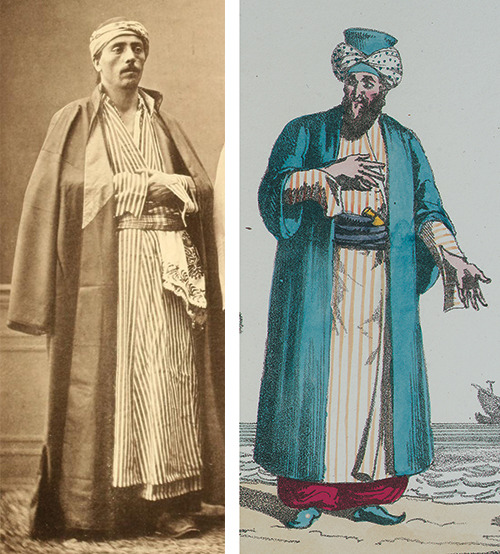
Left: ‘Christian
from Konya, Turkey’ (1873), Les costumes
populaires de la Turquie en 1873, Osman Hamdi Bey, p. 155; Right: Jewish
Turkish Merchant, 1821 (AR 2394)
The only discernible difference between both costumes is the
hat, the Jewish merchant is depicted wearing a kavese, a traditional Jewish
headdress, typical of this period. All other elements of their clothing is almost exactly the same, both men are
wearing outer robes known as djubba and a wide waist band over a long striped robe
known as an entari.
Before the outbreak of the First World War certain
traditional items of dress, such as the entrai, were worn by Sephardi men and
women and by people from different religious communities. The Jewish Museum has
a number of examples of entari from the late nineteenth and early twentieth
centuries that illustrate the significance of dress for the Sephardi community
in particular. These objects, when seen as primary sources of historical
evidence, can often provide us with a new insight into the past.
Below are two entari that date from the late 19th century,
and which are carefully stored in the archives of the Jewish Museum. The
garments have a very similar silhouette, they are both made from high quality
woven silk, and are fastened with delicate fabric covered buttons.
This fabric
would have been expensive and the vast amount of fabric used in making these
robes is demonstrative of the wealth of those people who purchased and wore
them.
As mentioned, both men and women wore these robes, the main difference
between them was the shape of the neckline. The low neckline of the women’s
robe would have allowed for a chemise or dress to be seen underneath, while the
man’s robe has a high neck with a small collar.
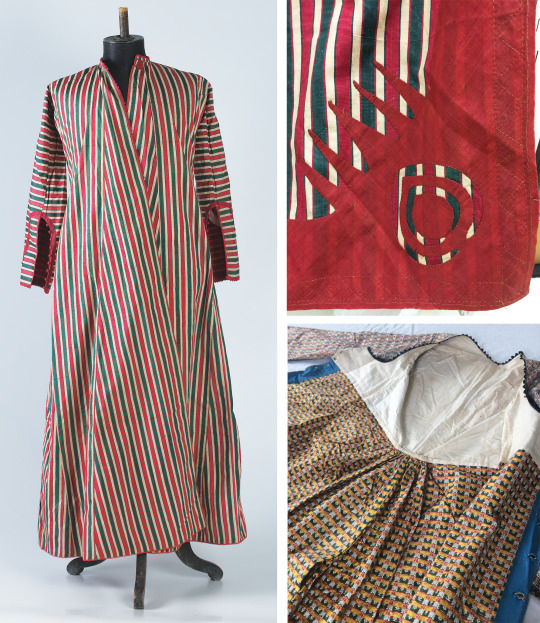
Left: Man’s entari, 1836-1870 (C 2003.5.10); Top Right: Detail
of hand sewn lining on inside of man’s entari, 1836-1870 (C 2003.5.10); Bottom Right:
Detail
of inside of women’s entari, 1836-1870 (C 2003.5.7)
The robes are in very good condition, showing little signs
of wear and small careful repairs, all of which indicate that this was a
precious garment only worn on special occasions. On close inspection of the
inside seams of both garments it’s evident that they were hand sewn, rather
than being sewn on a machine, further indicating that these garments were made
with great care and at great expense.
Another beautiful Sephardi item in the collection that
resides in the stores is the uniform of Aslan Bey Levy Orebi. Orebi was a
member of the Cairo Jewish community, and was given the noble title of Bey in
1913 by Sultan Abdul Hamid, for services rendered to the Ottoman Empire.
This
uniform and its accompanying sword were virtually all that his son was able to
bring with him when he was forced to leave Egypt in the wake of the Suez Crisis
in 1956.
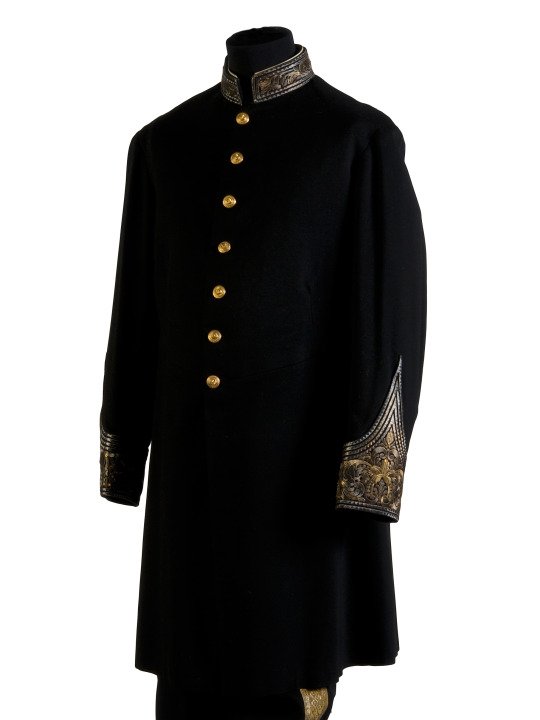
Bey uniform, 1913 (2008.14.1-2)
The uniform itself is made of a fine black wool with heavy
gold and silver embellishment on the sleeves and collar. The desire of Orebi
and his family to safeguard this uniform and its story for future generations,
suggests that this was an object of great value and a symbol of status within
the wider community of Cairo.
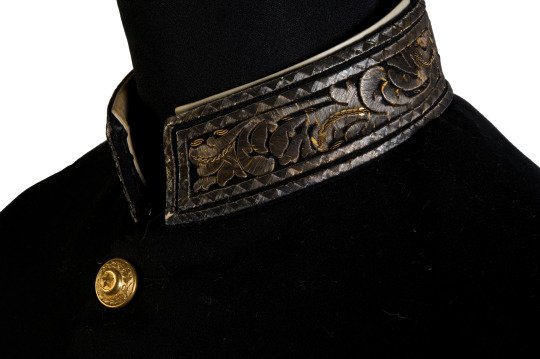
Bey uniform collar, 1913 (2008.14.1-2)
Rich embroidery and fine brocade fabrics have always been at
the heart of traditional Sephardi dress. The Laura Kadoorie School for Girls
taught poor and orphaned young women the skills of dressmaking and embroidery
in Baghdad in the early 20th century. These skills were essential for making a
living as part of the successful dressmaking industry in Iraq at this time, and
also ensured the preservation of such skills for the Iraqi Sephardi community.
The Jewish Museum has a number of the items that were made in this school,
including the baby’s hat pictured below. This hat was made as a sample garment,
on which the students would practice cutting, sewing and embroidery.
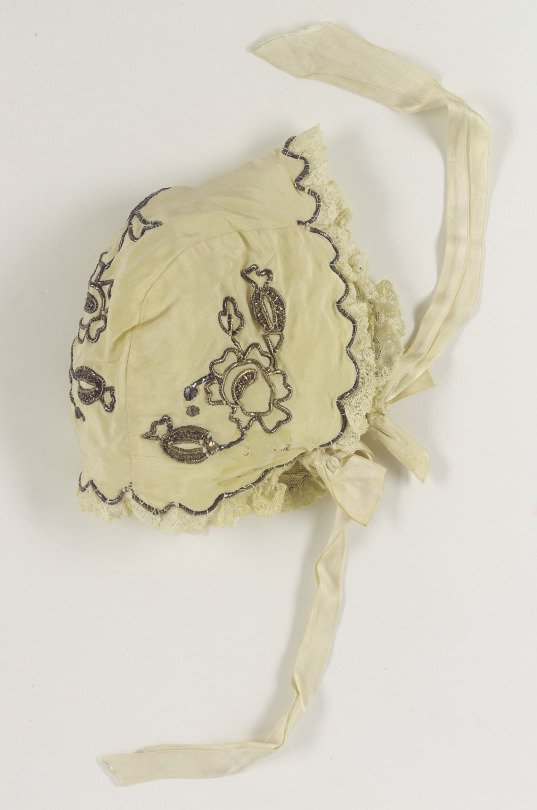
Baby hat, 1930s (1998.34.13)
Throughout history, dress in the Sephardi community
fulfilled many requirements, such as an indication of status, as a ritual item
or as a means of generating income. Dress has also been kept and preserved as
something precious, not just for of its monetary value, but because it has an
important story to tell.
Help us grow our collection of Sephardi objects! The objects shown here were given to the museum by Sephardi Jews who settled in the UK. We would love to have more Sephardi objects in our collection. Do you have objects representing your own story that you would be happy to donate to us? Email [email protected] and let us know.